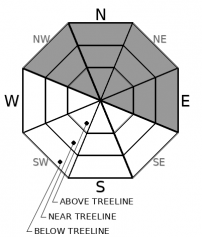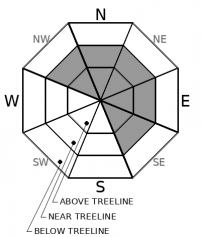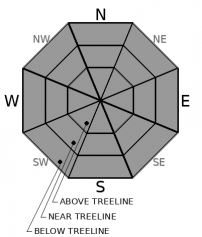| Tuesday | Tuesday Night | Wednesday | |
|---|---|---|---|
| Weather: | Mostly cloudy. Slight chance of snow in the morning, then snow in the afternoon. Snow levels below 7000 feet. Chance of precipitation is 80%. | Cloudy. Snow. Snow levels below 7000 feet. Chance of precipitation is 100%. | Mostly cloudy. Scattered snow showers. Snow levels below 7000 feet. Chance of precipitation is 50%. |
| Temperatures: | 28 to 33 deg. F. | 25 to 30 deg. F. | 32 to 38 deg. F. |
| Mid Slope Winds: | South 10 to 15 mph with gusts to 25 mph. | South 15 to 25 mph. Gusts up to 30 mph increasing to 40 mph after midnight. | South 15 to 30 mph. Gusts up to 45 mph. |
| Expected snowfall: | 80% probability of 1 to 3 inches. 20% probability of 3 to 6 inches. | SWE = up to 0.25 inch. | 70% probability of 5 to 8 inches. 30% probability of 8 to 12 inches. | SWE = 0.50-0.85 inch. | 60% probability of 1 to 2 inches. 40% probability of 2 to 4 inches. | SWE = 0.15-0.25 inch. |
| Tuesday | Tuesday Night | Wednesday | |
|---|---|---|---|
| Weather: | Mostly cloudy. Slight chance of snow in the morning, then snow in the afternoon. Snow levels below 7000 feet. Chance of precipitation is 80%. | Cloudy. Snow. Snow levels below 7000 feet. Chance of precipitation is 100%. | Mostly cloudy. Scattered snow showers. Snow levels below 7000 feet. Chance of precipitation is 55%. |
| Temperatures: | 23 to 29 deg. F. | 21 to 26 deg. F. | 26 to 31 deg. F. |
| Ridge Top Winds: | South 15 to 30 mph. Gusts up to 40 mph increasing to 55 mph in the afternoon. | South 20 to 35 mph with gusts to 80 mph. | Southwest 30 to 45 mph shifting to the south 35 to 60 mph in the afternoon. Gusts up to 105 mph. |
| Expected snowfall: | 70% probability of 2 to 4 inches. 30% probability of 4 to 7 inches. | SWE = up to 0.30 inch. | 70% probability of 6 to 12 inches. 30% probability of 12 to 17 inches. | SWE = 0.55-0.85 inch. | 60% probability of 1 to 3 inches. 40% probability of 3 to 5 inches. | SWE = up to 0.40 inch. |





























